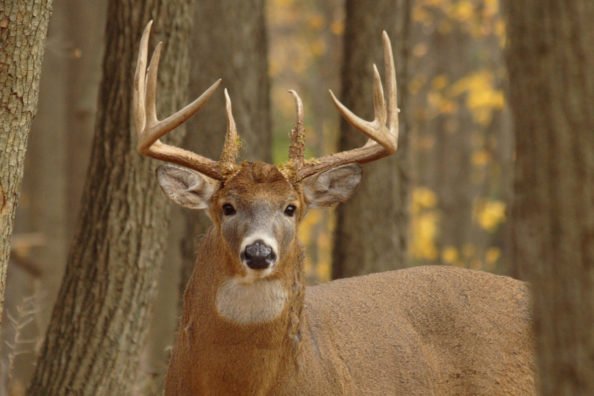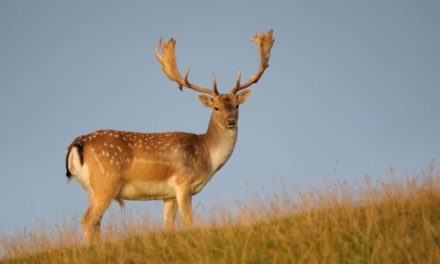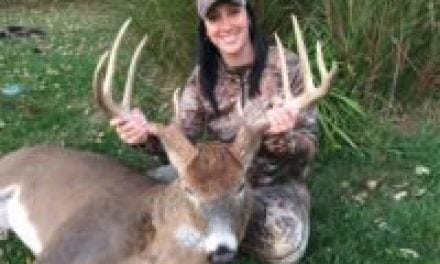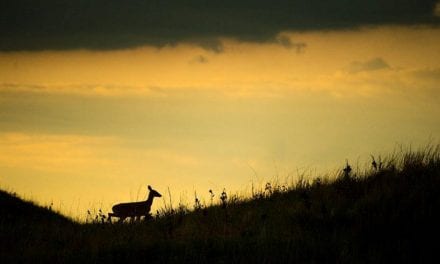
What sounds do whitetail deer make?
Whitetail deer are crafty animals, and figuring out their habits and behaviors is one of the most difficult parts of deer hunting. More specifically, figuring out all the different sounds deer make and what they mean is one of the hardest parts.
Thankfully, humans have been studying different deer sounds for years and we have a pretty good idea of what they’re saying.
Learning these different vocalizations and what they mean will make you a better hunter.
Grunts
This is one of the most common deer vocalizations you’ll hear in the woods, there are many different variations on it, and they all mean a different thing.
A contact grunt or social grunt is simply a low and quick “urp” sound. Both bucks and does use social grunts or contact calls to identify themselves to other deer and announce their presence in an area. A buck grunt tends to be deeper and more guttural than a doe grunt, which sounds a bit more nasal and higher pitched in nature.
Both sexes use these social grunts to establish a social hierarchy. I’ve had does feeding out in front of me that started sparring with the younger deer and chasing them off. The whole time the dominant, oldest doe of the group was making this grunt noise. I could tell when she wanted to make a point because the call became deeper, more aggressive and raspy-sounding in nature.
Deer grunts are also used to convey a softer message. Just check out the video above of a doe calling to her fawn. It’s a soft, almost cooing “urrrrrp.” It’s almost as if the doe is asking of her fawn: “Can you come here, little one?”
When you actually see a deer making these sounds and understand the context in which they were made, you can almost infer what the deer is saying based on the tone of grunt.
The Well-Known Buck Grunt
Of course, most of us know grunting as something bucks do during the rut. Again, there’s a range of grunt sounds male deer use during the rut.
Dominant bucks will use short grunts to stake out their territory and intimidate rivals. Bucks sometimes use similar short grunts when they’re chasing does. Some people refer to these as trailing grunts. It’s unmistakable when you hear these grunts, it’s one of the most exciting sounds in the woods. It means a buck is coming through fast and hot on the trail of a doe. You’d better be ready.
You’ll usually hear an excited “urp-urp-urp-urp” sound accompanied by the sounds of crunching leaves and branches breaking loudly as the deer approach.
There is also a tending grunt, which tends to be a more guttural “urrrrrrrrrrrp” sound. If you watch videos of bucks making this sound, you’ll also notice they mix in the short-but-aggressive short grunt sounds too.
There is some disagreement on exactly what these tending grunts mean. Some people believe it’s the buck’s way of trying to coax the doe to mate with him. However, we wouldn’t be surprised if it also had a double meaning as a way to send a message to potential rivals: “She’s mine! Stay away!”
Either way, the short grunts, tending grunts and trailing grunts are all great sounds to emulate with your grunt call. If a mature buck is angry and frustrated enough, these calls should bring him right in.
Slightly less common is the “buck bawl,” “growl,” “rage grunt,” “breeding bellow,” or “buck roar.” Whatever you want to call it, it’s unmistakable when you hear it. And it’s usually just big bucks that are making this sound when they are around an estrous doe.
It’s a low, eerie and guttural sound that we’d have a hard time believing came from a deer had we never heard it. See the video above to hear what we mean.
If you thought the buck sounded like he was frustrated, that’s because he was. Rutting bucks have been known to throw out this call if they’re lonely or if they’re with a doe that hasn’t allowed them to breed yet.
There have been many grunt calls that have come out in recent years to emulate this sound. We would say this isn’t a buck call to try every time you go out. Do it wrong and you’ll probably scare more deer than you’ll attract. But if all else has failed and it’s looking like you’ll be eating tag soup anyway, it’s a call to consider trying.
Deer Bleats
Doe bleats are interesting. Much like grunts, it seems bleats have many different meanings depending on the situation.
Last year, I watched two big groups of does interact in a food plot. The lead does, when they met in the center, uttered a mew-like bleat call that I can only assume was the deer equivalent of “Hello.” At least, that’s the way it looked from where I was sitting in a ground blind nearby.
Most hunters know about estrus doe bleats. A doe makes this loud mew/urp sound when they’re in heat but there isn’t a buck nearby. The intensity of this call depends on how long the doe has gone without a suitor.
Most of the can-style calls you see for sale today are made to emulate a more desperate mating call. When the doe makes an estrus bleat, she’s basically saying: “I’m ready to mate! Hurry, or you’ll miss your chance!”
But does use bleat sounds all year-round for communicative purposes. They definitely use them to convey things to their fawns.
I have also witnessed young fawns using bleats in a playful manner as they chase each other around a food plot. There are probably many other subtle meanings behind many of the bleat sounds we hear. We just can’t understand them all.
We can, however, make a good guess. In the case of the young fawns chasing each other, it was like watching some children laughing and playing tag in the park. They were simply having fun!
Fawn bleating can also include a high-pitched distress call. Unlike the other bleats, it is a very distinctive, agonizing sound that can trigger a doe’s maternal instincts like no other. This is, naturally, a great call to use for coyote hunting.
Snort-Wheeze
The snort-wheeze is an intimidation call. I must admit, I’ve never heard this one in person. It’s just not a deer call one hears very often. This one has a sound like the deer is trying to clear some stuffed-up sinuses.
This is the call mature bucks like to use in the pre-rut and rut when they want to intimidate a rival away from their does.
This call sounds exactly like it is described. It’s a short, loud sniff or snorting sound followed by a long wheeze. This one takes hunters by surprise sometimes, because it doesn’t sound anything like the more common grunts and bleats.
It’s also worth noting that bucks sometimes use the two parts of the snort wheeze on their own. For a large, dominant buck, they might only need to give a single snort to send a younger rival packing.
Whatever sound they use, if you see and hear a buck making these sounds, do a scan of your surroundings. It is likely there is another buck in the area that you haven’t spotted yet.
Blowing
If you’re new to hunting, this is the most likely deer vocalization you will hear first. Veteran hunters know what I’m talking about.
There are several stages to a doe sensing danger, and the annoying thing is, every one of them escalates as they warn other deer in the area that something just isn’t right.
Big, mature does especially are the ones you’ll hear blowing the most. These does are the wise old matriarchs of their group, and they’re always on the lookout for danger. Usually, if a doe spots you, it’ll start out with a stare down and then the doe will start stamping her feet.
The foot stamping says to other deer: “Hey, something isn’t right here, be on alert!”
Once the doe is certain there is danger, she’ll loudly start blowing. It’s a very shrill sound, almost like a whistle. If it makes you jump when you hear it, that’s what the doe intended.
Once a doe starts making this sound, it’s game over for your hunt. Does who have been spooked will often run off while continuing to make the sound as they vanish out of sight.
Obviously, this is the one call you don’t want to hear or emulate!
Knowledge is Power
Learning the sounds deer make can make you that much better at deer calling. But it also helps you to understand why deer act the way they do in certain situations. Knowing what each deer sound means and what prompted the deer to make it will help make you a better hunter in the long run.
For more outdoor content from Travis Smola, be sure to follow him on Twitter and check out his Geocaching and Outdoors with Travis Youtube channels.
NEXT: THE GREAT BIG OKLAHOMA DEER HUNTING GUIDE
WATCH
The post Deer Sounds: Making Sense of the Noises You Hear in the Deer Woods appeared first on Wide Open Spaces.
















